
Beyond developing cleaning skills, VR and AR training empower facility cleaning managers to address time management issues by immersing staff in simulations that promote better efficiency and workflow planning.
“A scenario where workers must clean a larger area within a limited timeframe can help them develop practical time management skills,” says Segura. “They can learn to prioritize tasks, allocate resources efficiently, and work under pressure.”
In addition to teaching janitors how to better manage their time, VR and AR can help facility cleaning managers free up their schedules. Not only do these solutions allow managers to relinquish their role as trainers, but they provide new recruits with tools that accelerate learning.
This year, ISSA partnered with a technology company to develop an AR application that helps cleaning managers address the issue of high turnover rates. According to the technology company, the goal was to standardize and improve the training process, thereby allowing janitors to take the lead.
“In-house service providers have to constantly train because they have a high turnover of frontline staff,” says the company’s spokesperson. “This solution makes training easier as you hire new people. You just hand them a tablet, tell them which room to clean, and they train themselves.”
Supervisors scan the room using light imaging detection and ranging (LiDAR) technology and affix augmented reality icons to items that need to be cleaned, such as the toilet or sink. Next, they add digital information, such as step-by-step procedures, lists of cleaning products, how-to videos, and more. When trainees enter the room, they press the icon that corresponds to the surface they’re cleaning and access the digital content needed to complete the job.
As Segura points out, solutions like this facilitate remote training, which is especially beneficial for facilities with multiple locations.
“Managers and custodians can receive consistent training regardless of their geographical location,” he says.
VR and Customer Service
Improving efficiency and time management are not the only benefits of VR and AR technologies. According to Brandon Hall Group, a Boca Raton, Florida-based research and advisory firm, VR is also effective for human skills training. By simulating real-world scenarios in which employees interact with other staff members and customers, users can enhance communication skills and foster empathy.
Hilton Hotels is employing VR to help corporate employees understand what it’s like to work at the front desk, as a housekeeper, or as a room service worker. Simulations include tasks such as cleaning rooms or setting up room service trays. The goal is for managers to immerse themselves in these scenarios so that they gain a better appreciation of how their decisions impact service teams.
“VR has been shown to increase empathy by letting people step into someone else’s shoes,” notes Bailenson. “Experiencing the physical and emotional demands of housekeeping can build respect and understanding among corporate employees.”
Segura echoes this sentiment and emphasizes the value of understanding the intricacies of the service roles inside facilities.
“Utilizing VR to enhance corporate employees’ empathy toward housekeeping staff is a fascinating and innovative approach,” he says. “Hilton’s VR initiative has the potential to enhance workplace culture, improve communications, and promote a more inclusive and respectful atmosphere. It’s a great example of how technology can be leveraged to create positive change in the workplace.”
According to a Business Insider report, 87 percent of the people who participated in the Hilton VR training program said the experience gave them more empathy and appreciation for the experiences of direct hotel staff.
Virtual Baby Steps
Experts agree that facility cleaning managers who are interested in incorporating VR or AR into their training programs should start with a small pilot program focused on one or two high-impact scenarios.
“VR should complement rather than replace existing protocols— integrated as a module within standard training,” says Bailenson. “A gradual rollout with short introductory sessions helps staff get comfortable with the technology.”
Once facilities have successfully incorporated the technology into their training programs, they can leverage it to measure training outcomes.
“VR systems can track metrics like task completion time, error rates, and procedural accuracy,” notes Bailenson. “These data points provide objective measures of skill improvement over time. Managers can then compare VR-based performance with on-the-job results to validate effectiveness.”
Once considered a novelty, VR and AR technologies are proving their worth as valuable training tools for janitorial staff—and an increasing number of companies are developing solutions that cater to the cleaning industry. By implementing immersive VR and AR technologies into their training programs, facilities can create a more engaging, effective, and supportive environment.
Kassandra Kania is based in Charlotte, North Carolina, and is a frequent contributor to Facility Cleaning Decisions.
Sidebar: Differences Between VR and AR
When adopting immersive technologies for training purposes, facility cleaning managers have a choice of virtual reality or augmented reality. The decision often hinges on budgets as VR hardware tends to have a higher upfront cost. Additionally, operating in a completely virtual environment can be unsettling and may cause motion sickness, although this is more likely in gaming and entertainment applications where fast or unexpected movements are the norm.
So, what are the key differences between virtual reality and augmented reality? VR blocks out the real world completely and immerses the user in a simulated digital world. To do this, users must wear a VR headset and use motion controllers that track hand and finger movements or allow them to interact with the environment by selecting and manipulating digital objects.
AR, on the other hand, overlays digital content, such as graphics and text, onto the user’s view of the real world using AR glasses or devices already in use, such as smartphones and tablets.
Virtual Reality is a Training Tool for Frontline Staff

 The Down and Dirty on Cleaning in Virus Season
The Down and Dirty on Cleaning in Virus Season How Surfactant Use is Expanding in Commercial Cleaning
How Surfactant Use is Expanding in Commercial Cleaning